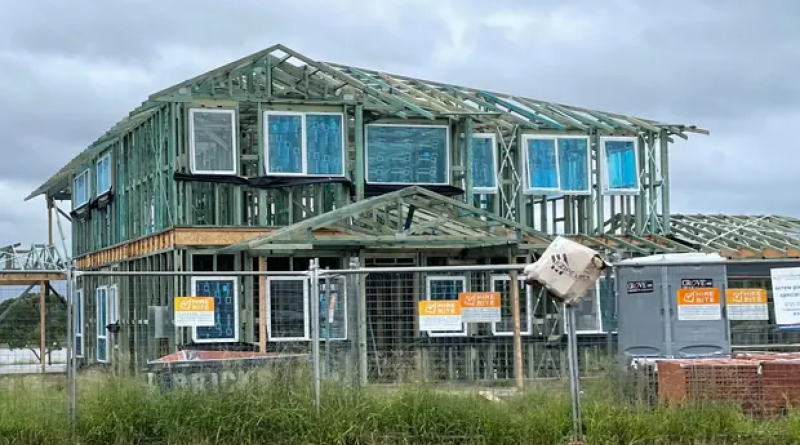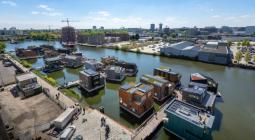Property developers fight NSW bid to make houses more energy-efficient and climate-resilient

Environmentalists call changes ‘everything you could ever dream about’ but industry says they ‘undermine the economics of delivering housing’
Property developers in New South Wales are fighting against the introduction of a wide-ranging planning policy aimed at ensuring houses are more energy-efficient and climate-resilient, which one environment group described as “everything you could ever dream about”.
Public comment closed last month on the draft Design and Place state environmental planning policy, hailed late last year by the then planning minister Rob Stokes as “NSW’s first comprehensive design policy”. It would offer “an important opportunity to reshape the look and feel of the places we live in”.
The policy included pushing for new commercial buildings to be net-zero carbon emissions from “day one”, apartment blocks to be built with electric vehicle charging stations and a required minimum tree cover for developments.
The plan also required “comprehensive hazard risk profiles”, including floods and bushfires, for new developments. The demand has gained relevance in the aftermath of recent floods in Sydney and elsewhere in the state, with thousands of homes already approved to be built in flood plains.
It was also one of the government’s key planks to achieve the state’s 2030 target of cutting carbon emissions by 50% from 2005 levels. Other elements include huge renewable energy zones to speed up the power industry’s decarbonisation and initiatives to get more electric vehicles on the road to shift transport off fossil fuels.
However, Stokes was demoted soon after he released its draft and replaced by Anthony Roberts as the new planning and housing minister. Roberts’ office declined to provide a comment on the minister’s stance but it is understood he is not a supporter.
Brett Whitworth, the deputy planning secretary, told NSW estimates earlier this month the draft planning policy had received more than 350 submissions. Asked if the department had been given any direction on the policy from the minister, he said, “no, we have not”.
“[Roberts] made the point that he wanted to ensure that there was no impact on the ability to deliver homes and homes already in the pipeline,” Whitworth said.
According to the government’s commissioned cost-benefit analysis, the policy would add costs of $2.3bn over 30 years but be outweighed by almost $3.3bn in benefits. Despite that assessment, the industry has objected.
Luke Achterstraat, the Property Council’s NSW executive director, said the industry was “highly supportive of the objectives to create great places and deliver good design outcomes, which are essential to the long-term success and sustainable growth of our cities and regional areas”.
“However, as a package the [policy] is not currently supported as it creates more subjectivity and uncertainty in already complex planning system,” he said.Steve Mann, the chief executive of the Urban Development Institute of Australia, said his organisation, too, was “supportive of a principles-based policy to improve design quality and environmental outcomes in NSW”, but called on the government to cancel the new planning policy.
“[T]he approach taken … would have undermined the economics of delivering housing across the spectrum including social and affordable housing as well as private housing,” Mann said. “This would be a disaster for providing key worker housing, ie teachers, nurses, those on low income and disability housing.”
Jeff Angel, the executive director of the Total Environment Centre, said it was clear the construction and housing industry groups were demanding the plan’s demise.
“It’s so detailed, it’s incredible,” Angel said, noting planning had provided briefing points to environmental groups. “It’s got everything you could dream about.
“It would affect every development in the state, not just Sydney,” Angel said, adding industry associations “talk the talk” about building sustainably “but nothing happens underneath”.
The Coalition’s political rivals say the government would shed credibility about the seriousness of its climate policy if it ditched the policy.
Housing “is a large emitting sector, and collectively, we have to deal with it in the future”, said Paul Scully, Labor’s shadow planning spokesperson, adding “an incredible amount of work had gone into it just for them to abandon it”.
The Greens MP David Shoebridge said that after the last two years of extreme weather events driven by climate change, governments needed to be taking much stronger steps on reducing emissions.
“We have already seen this government scrap rules on climate and fire readiness just weeks after they came into force, so, of course, we are all anxious,” Shoebridge said.
“Even if these changes come into effect they will only reduce greenhouse emissions by 11% from business as usual and if we can’t meet that target then we are in a world of trouble on climate,” he said.
The independent NSW MP Justin Field said that Roberts would leave “a terrible legacy” if he spiked the reforms without a credible replacement.
“It is clear the only interests being served are those of the big property developers who will pocket any upfront cost savings while the ongoing costs will be paid by the community and households,” Field said.
Residents would “suffer the loss of green space and be left with less climate-resilient homes that are more expensive to run and less comfortable to live in”.
Davina Rooney, chief executive of the Green Building Council of Australia, said the organisation strongly supported the Sepp’s concepts.
“Net zero, climate change, greener spaces are the key issues of our time,” Rooney said, adding the council had “collaborated heavily” with the government on the plan.
Rooney noted Stokes, now the minister for infrastructure, addressed a recent council conference, saying the climate “would not wait for a convenient time in the economy”.
“Our question in light of recent events [to scrap the Sepp] would be if now is not the right time, then when?” Rooney said.
Author: Peter Hannam
Phtograph: Peter Hannam






